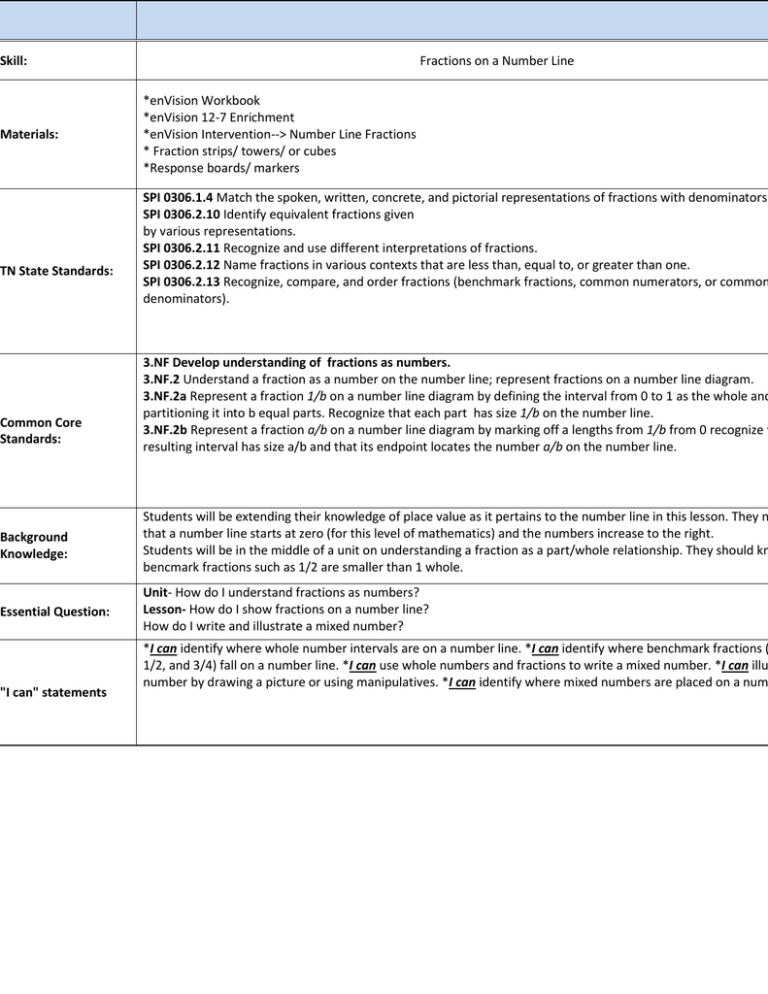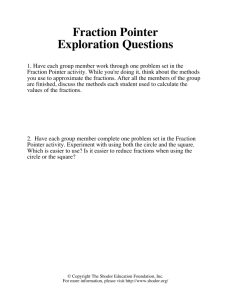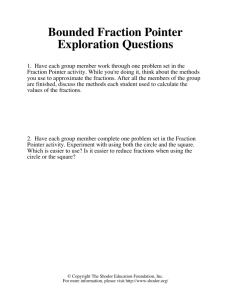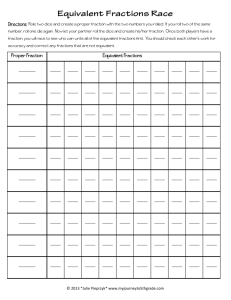Skill: Fractions on a Number Line Materials: *enVision Workbook
advertisement

Skill: Materials: TN State Standards: Common Core Standards: Fractions on a Number Line *enVision Workbook *enVision 12-7 Enrichment *enVision Intervention--> Number Line Fractions * Fraction strips/ towers/ or cubes *Response boards/ markers SPI 0306.1.4 Match the spoken, written, concrete, and pictorial representations of fractions with denominators SPI 0306.2.10 Identify equivalent fractions given by various representations. SPI 0306.2.11 Recognize and use different interpretations of fractions. SPI 0306.2.12 Name fractions in various contexts that are less than, equal to, or greater than one. SPI 0306.2.13 Recognize, compare, and order fractions (benchmark fractions, common numerators, or common denominators). 3.NF Develop understanding of fractions as numbers. 3.NF.2 Understand a fraction as a number on the number line; represent fractions on a number line diagram. 3.NF.2a Represent a fraction 1/b on a number line diagram by defining the interval from 0 to 1 as the whole and partitioning it into b equal parts. Recognize that each part has size 1/b on the number line. 3.NF.2b Represent a fraction a/b on a number line diagram by marking off a lengths from 1/b from 0 recognize t resulting interval has size a/b and that its endpoint locates the number a/b on the number line. Background Knowledge: Students will be extending their knowledge of place value as it pertains to the number line in this lesson. They n that a number line starts at zero (for this level of mathematics) and the numbers increase to the right. Students will be in the middle of a unit on understanding a fraction as a part/whole relationship. They should kn bencmark fractions such as 1/2 are smaller than 1 whole. Essential Question: Unit- How do I understand fractions as numbers? Lesson- How do I show fractions on a number line? How do I write and illustrate a mixed number? "I can" statements *I can identify where whole number intervals are on a number line. *I can identify where benchmark fractions ( 1/2, and 3/4) fall on a number line. *I can use whole numbers and fractions to write a mixed number. *I can illu number by drawing a picture or using manipulatives. *I can identify where mixed numbers are placed on a num Set/Hook: Key Vocabulary Attention Grabber: Human number line--> (Before Class) Write 0; 1/4; 1/2; 3/4; 1 on post-it notes. Draw a num the board. * (In Class) Ask for 5 volunteers. * Put one post-it on each child's forehead, so that they cannot see the number on their head. * Without talking ask students to put themselves in order from least to greatest. * After students have arranged their numbers, ask a volunteer in the class if the students are correct. * If they are correct students will place numbers on the number line. *If students are not correct, the student checking will tell how many numbers are in the incorrect place. * After two attempts, the whole class will correct any errors. Relate to Previous Learning: (Up to this point students have been exposed to benchmark fractions and introduc equivalent fractions.) Say, today we are going to explore to see what benchmark fractions and equivalent fractio common. (aka, place on a number line) Relate to Real Life: Exploration/ Investigation Time During this time, students will work independently for at least five minutes to see what patterns that they can se fraction strips, bars, or towers to identify and compare fractions. The question presented will be, "How could I u bars to show all of my fractions from 1/8 to 1 on one line?" Students will be placed into groups of 4 or 5 to inv discuss answers. The goal of this activity is for students to create a fractional number line by marking the intervals from each frac here, they should be able to see a relationship of a fractional number line having a similar appearance to a ruler make a ruler a functional math reference tool for students when working with mixed numbers and fraction num fraction number line number Agenda: Independent Practice: Closure: * Human Number Line (5 minutes)* Explore/ Investigate (10-15 minutes)* Introduce EQ's, I can's, and Vocab (5 Students should readily know the definitions for fraction and number line at this point from prior lessons and ex - Write the word mixed number on the board. - Have students write what they think the number means on board and give an example. - Discuss student answers and then discuss the correct meaning of the term. * O Extention or if time allows (http://www.brainpopjr.com/math/fractions/mixednumbers/) (5 minutes) * Br Quiz could be used as a formative assessment to make sure that students have at least a basic understanding th mixed numbers. * Complete Problem Solving Number line problem together. (See Power Point Print Out) (5 mi Students will need their Envision Math Workbook for their independent practice. Ask students to complete the f line as a group at their table, students may work together using their sets of fraction towers. (5 minutes)* Fill in together. (5 minutes)*** Dependinding on their level of understanding I would take this lesson in two different directions*****IF students still seem to be struggling, I would illustrate with their fraction towers what a fractio could look like. Students should see that each fraction set is equal to one whole (for example 4/4 is equal to fou would begin by sticking 1/4 on the end of a 1 whole bar and ask students what number is represented (1 1/4), th and again ask the students what number is represented (1 2/4 or 1 1/2). I would then show another bar underne illustrating 1 1/2 so that students could physically see that 1 2/4 is equivalent to 1 1/2. I would extend this activ felt like students were comfortable with the concept. *I would also use this illustration to work with my student appear to be able to work independently with this skill.* (10-20 minutes)*If students appear to be grasping the would ask them how we could use our numberline to order from least to greatest or greatest to least. We would concept of the number line being that as the number goes to the right from zero it increases, as a number goes toward zero it decreases. (5 minutes)* From here, I would ask students to give me a thumbs up, thumbs down, the middle to assess their level of understanding. (5-7 minutes) *Thumbs up- move to a table together and working independently, using the manipulatives as needed. *Thumbs in the middle & down- would continu with me to complete problems 3 and 4 on work page. *From here, I would again ask students to give me a thum or in the middle. From there, students will move into three groups (which they may at any time switch if they ne work. Thumbs up will continue working independently, thumbs in the middle will work independently with teac monitoring, thumbs down students will work directly with teacher until they are comfortable workinging indepe 20 minutes)*Closure (5-10 minutes) Envision Math Series Workbook Page 73 & 74 (Lesson 12-7) Verbalization of learning by students: Think-pair-share missing number on number line posted on board. (See P Point)Demonstration of skill by students: Exit Ticket--> Write one mixed number, fill in missing blanks on numb the follow numbers in order from least to greatest 3/4; 1/4; 1/2; 1 ; 0 (See attached power point and exit ticke Teaching Strategies/ Differentiated Instruction: Modifications: Formative Assessement: Summative Assessment: Bloom's/ HOT Questions: *Students will begin lesson grouped homogenously. *Students will be able to collaborate with peers while investigating this new skill. *Students will be able to use manipulatives to complete assignments as needed. *Student grouping is flexible and determined by student understanding at check points throughout the lesson. *Students will be provided with different levels of support/ scaffolding depending on their understanding of the * IEP students or students with a history of struggling will be intially paired with a higher level student for suppo * The intervention resources from Envision Math (attached) will be used for students who continue to struggle * Frequent observations of student work. * Student reflection of knowledge (thumbs up/ thumbs down) * Completed student work This skill will be summatively assessed with the fraction unit test. *Students will be asked to create a number line including fractions and mixed numbers up to 6. They will then series of questions about the number line that they created. (See Attached) *Students will then compare fractions from least to greatest using the above number line) *Students will have a fraction project due at the end of the unit, one option for the project will be for student map style numberline with at least 4 different destinations shown. Students will then write 5 questions about line that they could ask a friend. Remembering: What is a fraction? What is a benchmark fraction? How do I write a fraction? How do I write a wh How do I write a mixed number? Understanding: How would you describe a mixed number to a friend who has never heard of a fraction before? time that it would it be helpful to select a smaller equivalent fraction? Applying: When could you use a mixed number in your everyday life? Analyzing: What is difference between a fraction and a mixed number? What is the difference between a whole a mixed number? Evaluating: Sally says that a mixed number will always be bigger than a whole number. Is Sally correct? Defend/ answer. Creating: How could construct a mixed number using your fraction cubes?






